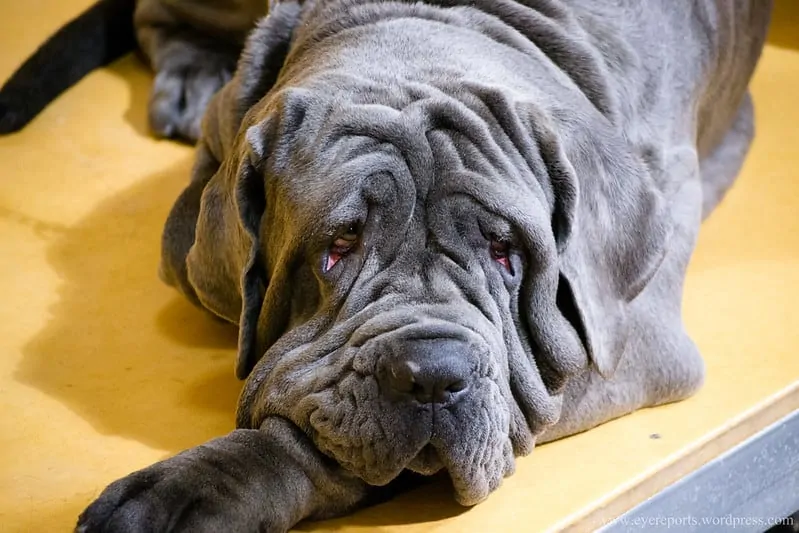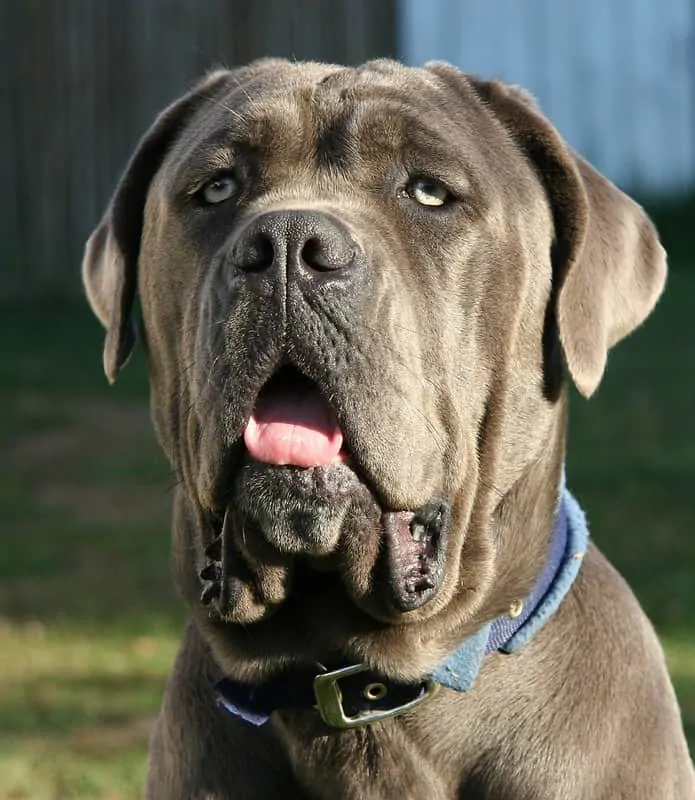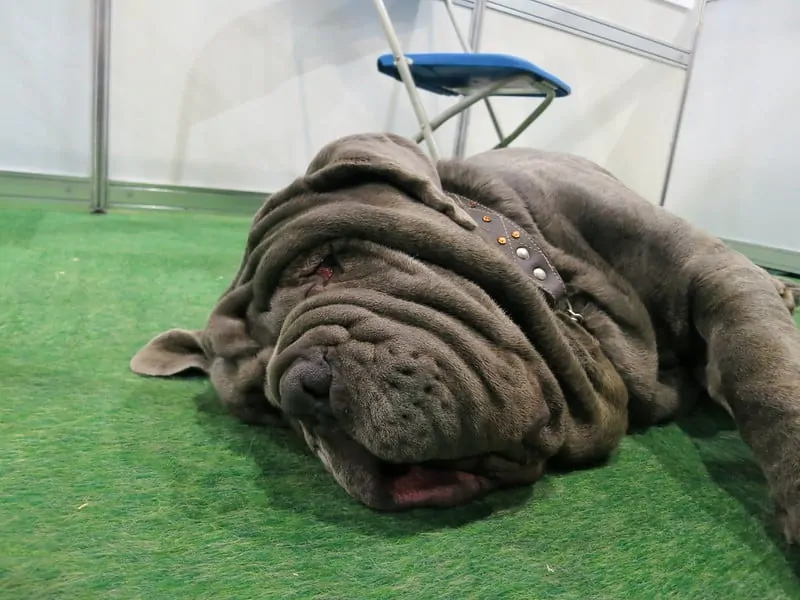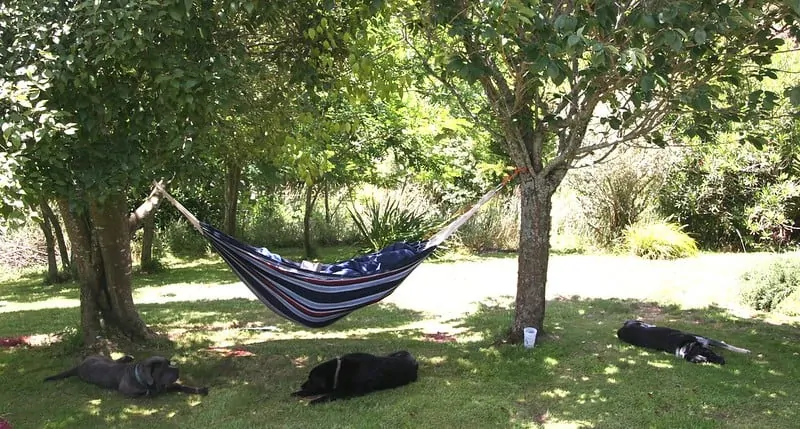When it comes to dogs you don’t want to run into in a dark alley, the Neopolitan Mastiff or Mastino Napoletano certainly has to be high on the list. This quintessential mastiff breed is huge, intimidating, and fearless. But don’t let the heavy stare and massive jaws of the Neapolitan Mastiff turn you off to the breed altogether.
For the right owner, this loyal and distinguished Neapolitan Mastiff is the perfect companion.
Keep reading to find out if the same is true for you.
Contents
General Characteristics of the Neapolitan Mastiff
- Other names: Mastino, Mastino Napoletano
- Height: 24 to 31 inches
- Weight: 110 to 150 pounds
- Lifespan: 8 to 10 years
- Origin: Italy
- Colors: Grey/blue, black, mahogany, tawny, and reverse brindle
- Activity level: Low
- Grooming needs: Low
- Best suited for: Experienced guard breed owners with a large fenced yard
Despite being one of the rarer dog breeds, the Neapolitan Mastiff is easily recognizable due to their size and characteristic facial wrinkles, as classified by the American Kennel Club and United Kennel Club. “Neapolitan Mastiff” by Gomagoti / CC BY-SA 2.0
The History of the Neapolitan Mastiff
Neapolitan mastiffs descended from the Molossus dogs that lived in ancient Greece. The Molossians were a Greek tribe famed for their love of dogs and for keeping large, ferocious mastiff and herd guardian type breeds.
The mastiff-type Molossus is thought to be the forebearer of all modern-day mastiffs. These dogs were used for a number of purposes including hunting and guarding of property. When the Greek Empire fell to the Romans in the 8th century, these large mastiffs gained a new job fighting alongside gladiators in the ring and battling against other large carnivores such as jaguars and bears.
But it wasn’t until midway through the 20th century that the Neapolitan Mastiff we know today really started to take shape.
The varied mastiff-type breed standard popular throughout Europe for centuries was almost lost in Italy during the Second World War. It wasn’t until after the war ended that efforts were made to revitalize the mastiff and standardize the various types into specific breeds. From this effort, spurred largely by the popularity of the dogs in the show ring, the Neapolitan Mastiff and the Cane Corso were born.
A third variant, the Cane da Presa, which best represented the ancient Molossus, was lost during this period. Though, there have been some more recent efforts to bring the breed back. Many proponents of the Presa argue that it is a more true representation of what the Neapolitan was meant to be.
The United States Neapolitan Mastiff Club was key in introducing the breed standard to the United States.
All of today’s true mastiff breeds are descended from Molussus type dogs who existed in ancient Greece. These powerful animals were used to guard property and hunt and were even utilized to fight alongside soldiers during wartime. “SHA_3884” by Andrey Shkvarchuk / CC BY-SA 2.0
In any case, the Neapolitan Mastiff was reborn as a large dog with a heavy head and rolling, unmistakable wrinkles on the head, chest, and legs.
Today’s Neapolitan Mastiff is still frequently employed as a guard dog throughout the world. Their unfaltering bravery and tendency to sneak up on trespassers without first alerting them to their presence makes them unique among even the toughest of these dog breeds.
It’s this same unshakable personality that attracts many owners searching for a large companion dog to the breed. Their quiet dignity, undying loyalty, and calm nature make them a great choice for the right type of owner.
The Temperament of the Neapolitan Mastiff
Like many large-boned breeds, the adult Neapolitan Mastiff tends to be a bit of couch potato. They enjoy lying around the house or spreading out in a sunny spot in the yard. While they enjoy walks and playing games outdoors, they are equally happy to just observe the world as it goes by.
While younger Mastinos certainly have more energy than their full-grown counterparts, they aren’t as rambunctious as most puppy and adolescent dogs. Even still, these are powerful animals capable of knocking over even a full-grown man if they do get a burst of energy.
For this reason, it is important to set boundaries and instill some basic obedience in your Neapolitan Mastiff very early on–before they are large enough to overpower you.
The Neapolitan Mastiff is a regal breed with an intense stare. Thanks to their size, strength, and their undying loyalty to their owners, they have been used as protection and guard dogs throughout history. “Larger Lucy” by Tim Dawson / CC BY-SA 2.0
These dogs can be stubborn and tend to be independent thinkers, so training is not always easy, as noted by the American Kennel Club. They do respond well to positive reinforcement and aim to please so long as the task doesn’t require too much effort.
While these dogs tend to be very loyal with family, they are aloof and wary with strangers. Well-socialized, well-trained Neos are more welcoming of people they don’t know but there is always a potential for aggression with strangers, especially when guests are acting erratically or appear threatening.
Their instinct to guard is hard-wired and they require no formal training to protect people or property.
>>>Like big dogs? Here are some of the biggest breeds in the world.
These dogs will do best in a home that has a large, fenced yard that will allow them to observe the outside world and walk their territory at will. They can be very loving and affectionate with family and do not enjoy being left behind for long periods.
Overall, the Neapolitan Mastiff is an intelligent dog and a capable protector. They require early socialization to assure they aren’t too jumpy with new people or other canines and make a loyal family member as long as a few basic needs are met.
Learn more about the Neapolitan Mastiff in the above video.
Health Issues Common to the Neapolitan Mastiff Breed
Unlike most wrinkly skinned breeds, the Neo does not commonly suffer from skin problems or infections. And, overall, they tend to be relatively healthy dogs. However, like all large breeds, there are some serious health conditions they can suffer from.
Here are the most common health problems seen in Neapolitans.
- Cherry eye
- Ectropion/entropion
- Progressive retinal atrophy
- Hypothyroidism
- Elbow dysplasia
- Hip dysplasia
- Bloat
- Cardiomyopathy
Like all large breeds with barrel chests, the Neo is especially prone to bloat, a life-threatening condition that can progress quickly and kill within hours.
Bloat occurs when the stomach fills with gas and flips, causing blood flow to vital organs to be restricted. If caught early, it is possible to tap the stomach and release the gas to avoid torsion from occurring. If the stomach does twist, surgery is usually required to avoid shock and organ failure.
Because they have been heavily selectively bred for their exaggerated facial wrinkles and loose skin over the past sixty years, it is not uncommon for the Neapolitan Mastiff to suffer from eye problems such as cherry eye. “Grabbing Some ZZZ’s” by Waldo Pepper / CC BY-NC 2.0
Some Neapolitan Mastiff owners choose to have their dogs undergo gastropexy surgery when they are young. During this operation, the stomach is attached to the abdominal wall which should prevent it from twisting should bloat occur. This procedure is usually done while the dog is being spayed or neutered between six months and one year of age.
While it is impossible to completely remove your dog’s risk of bloating even with the surgery, there are a number of steps you can take to reduce their odds of suffering from the condition.
Most importantly, never exercise your Neapolitan Mastiff immediately after they have eaten. Allow at least two hours before engaging in lively activities with them to allow time for proper digestion. Splitting meals into smaller portions and feeding your dog two or three times a day can also be beneficial.
Even as your dog ages and struggles to eat out of a bowl on the ground, it is important that you never elevate their dog bowl as this appears to increase bloat risk. Monitoring your dog’s water intake and feeding a combination of wet and dry food, rather than just dry, can also help.
While even the most well-bred Neos are still prone to bloat, choosing your breeder carefully will help reduce the odds of getting a puppy with other health ailments common to the breed. If you would rather adopt a Neo, there are large breed and mastiff rescues around the world that work to place homeless Neos and Neapolitan Mastiff mixes with new families.
Do Neapolitan Mastiffs Do Well With Children and Other Pets?
Given their size, power, and protective nature, care should be taken when bringing a Neapolitan Mastiff into a home with children.
Mastinos that are well socialized with children of all ages as a puppy are more likely to do well with a family with young kids. However, even the Neapolitan Mastiff who shows great tolerance and affection for their own human siblings may not take well to young friends who come over to play.
Neapolitans can be quite happy in a home with other dogs so long as the other canines respect their need for rest and are happy to call them the boss. “Relaxin’ in the Garden” by Tim Dawson / CC BY-SA 2.0
Even older children need to be cautious when introducing friends to the dog and great care should be taken in making sure the dog is comfortable with the situation while an adult is present.
>>>Looking for a breed that does well with children? Here are the best dogs for families with kids.
In general, Neos aren’t overly fond of other dogs, either. They enjoy being the only dog in the house, though plenty of Neos live perfectly peacefully in a home with other canines, especially with those of similar size and activity level. Much of this depends on early socialization and the dogs’ own unique personalities.
They do tend to get along better with pets of different species, such as cats, and despite their ferocious guarding abilities, they really have little prey drive to speak of. If you want to keep a multi-pet household that includes a Neapolitan Mastiff, it is recommended that you introduce the Neapolitan Mastiff to many other animals while they are still a young puppy.
What to Consider Before Bringing Home a Neapolitan Mastiff
Think a Neapolitan Mastiff is right for you? Here are a few more things to consider before bringing one of these wrinkly giants home.
While female Neos only reach about 120 pounds, males can get over 150. Their substantial size is something to consider before bringing one of these hefty hounds into your home. “DSCN0530” by Jenna Fuler / CC BY-SA 2.0
Activity Level
These giants are typically happy to lounge around the house most of the day. They will be alert in situations that warrant their watchful eyes, such as when guests arrive or crowds move by the house and also tend to be more active at night. But overall, these dogs enjoy their sleep. A few walks a week, some playtime in the yard, and plenty of cuddling on the couch is likely to be all the activity a full-grown Mastino needs.
Younger dogs are likely to need slightly more exercise, but it is important not to overdo it while their bones and joints are still growing. Controlled walks on leashes are a great option.
Trainability
While they do tend to be stubborn and independent, these dogs are also highly intelligent and tend to pick up on new behaviors quickly assuming you use the right motivation. It is a great idea to enroll your Neo puppy in basic obedience as soon as possible so you can instill some basic behaviors before they get too big to handle. This will also help socialize them with other dogs in a controlled and positive environment.
Grooming
The Neo’s coat is short and easy to maintain. They tend to shed seasonally and will require the occasional bath if you want to keep them smelling their best. Their dropping lips and huge muzzle do mean these dogs tend to drool, so expect to keep a towel near the water bowl and use it frequently.
They need their nails trimmed often and may need their wrinkles checked periodically to assure no yeast or bacterial growth is occurring, especially in the areas around the mouth.
Young Neapolitans typically need a lot more activity than their adult counterparts. It is also important to spend a lot of time socializing younger dogs so they can grow into well-adjusted adults. “Sad Lucy” by Tim Dawson / CC BY-SA 2.0
Nutrition
Adult Neos will do well on any high-quality commercial or raw diet assuming it includes enough protein and quality animal ingredients. Neo puppies, on the other hand, require a large breed specific puppy food to assure slow, steady growth and healthy bones and joints as they age. You can switch your pup to an adult food once they have reached their adult weight around one year of age.
>>>Looking for the best dog food to feed your dog’s inner wolf? Check out our review for Orijen Brand dog food.
Cost
A purebred Neo puppy does not come cheap. You can expect to pay upwards of $2500 for a pup from a reputable breeder.
Overall, this is a large dog that requires a lot of food, ages rapidly, and will likely need some supportive veterinary care as they get into their golden years.
>>>Have an aging dog? Here are our picks for the best senior dog slings.
10 Fun Facts About the Neapolitan Mastiff
Now that you know what it takes to own a Neo, here are few fun facts about the breed.
- Neos traditionally have their ears cropped very close to the head, but now that docking and cropping are going out of style, it is much more common to see these dogs with their natural lop ears.
- Like traditional bulldog breeds, the Neo was once used to bait bulls and other large animals.
- Silver Mastinos are often referred to as being “blue” because of the rich dark grey color.
- Light mahogany Neos resemble Bordeaux Mastiffs, though Neos are distinguishable by their much larger size and looser skin.
- With their extra skin and large mass, these dogs do not do well in the heat.
Though less common than the blue coloring, tawny-colored mastiffs like this one are an accepted color for the Neapolitan breed. “DSCN0524” by Jenna Fuler / CC BY-SA 2.0
- A Neapolitan female holds the record for the largest litter, which contained 24 pups.
- “Mastino” means mastiff in Italian.
- The Neo is most commonly seen with a grey or blue coat, but they also come in mahogany and tawny or blue, mahogany, or tawny reverse brindle.
- Neos were used as war dogs by the Roman army. They have lifespans of up to 10 years
- Mastiffs have been depicted in multiple ancient carvings and paintings throughout Europe, Asia, and Northern Africa as far back as 3,000 BCE.
Before You Go
Not sure this noble giant is right for your lifestyle? Here are a few more breeds to consider.
“Lucy, Again” by Tim Dawson / CC BY-SA 2.0

Sara Seitz has spent most of her life in the pet industry and has a bachelors in animal behavior from Colorado State University. Sara started working with dogs and cats as a high schooler at a rural boarding kennel. There she learned a lot about the bad and the ugly of the pet service industry. But not even the toughest day at that job would dissuade Sara from following her dream of working with animals.
In college, Sara got a job at a dog daycare and boarding facility in Fort Collins, Colorado. Her new career provided even more opportunities for learning about dog behavior than her classes did. As general manager of the daycare, Sara helped the company launch a new in-home pet sitting branch and trained to become a certified dog trainer. Between shifts taking care of peoples pets in-home and supervising dogs during playtime at the daycare, Sara organized and taught obedience classes.
Sara has always been passionate about bettering the lives of our canine companions. She soon found that advocating for and educating owners in the power of positive reinforcement training was one of the best ways to help dogs and their owners live happier lives.








